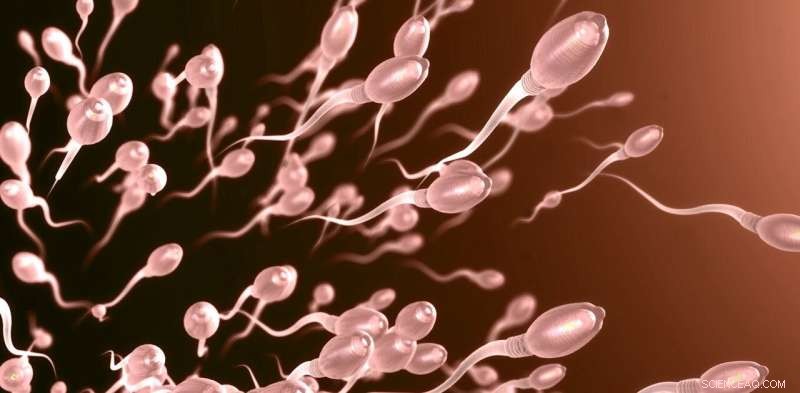
Il riscaldamento dei testicoli mediante nanorod influisce sulla produzione di sperma. Credito:Shutterstock
Le donne hanno una varietà di metodi contraccettivi, ma solo due metodi sono comunemente disponibili per gli uomini:preservativi e vasectomia. Entrambi i metodi hanno i loro svantaggi.
I preservativi possono rompersi e alcuni uomini sono allergici al lattice nei preservativi standard. Le vasectomie sono procedure chirurgiche che possono essere dolorose e difficili da invertire.
Quindi la ricerca di opzioni contraccettive maschili alternative continua e un metodo attualmente allo studio è la nanocontraccezione.
Un interruttore di accensione/spegnimento
La nanocontraccezione si basa sull'idea che le nanoparticelle - qui, di circa 100 nanometri di diametro, o circa un millesimo della larghezza di un pezzo di carta o di una ciocca di capelli umani - possono in qualche modo essere consegnate ai testicoli, dove possono essere riscaldate .
Se potessi riscaldare un po' i testicoli, avresti un modo per attivare e disattivare la produzione di sperma a piacimento perché più diventano caldi, meno fertili diventano. Ma è un processo delicato perché i testicoli possono essere distrutti irreversibilmente se diventano troppo caldi; il tessuto muore e non può più produrre sperma, anche quando i testicoli tornano alla loro temperatura normale.
L'uso della nanotecnologia per riscaldare i testicoli è stato studiato per la prima volta nel 2013 sui topi dal biologo Fei Sun e dal suo team di ricerca multidisciplinare. I suoi primi esperimenti prevedevano l'iniezione di nanoparticelle direttamente nei testicoli del topo. Queste nanoparticelle erano lunghe nanorod (o nanocilindri) di atomi d'oro - immagina un tubo lungo 120 atomi d'oro con un diametro di 30 atomi d'oro - rivestiti con alcune lunghe catene polimeriche sulla loro superficie. Sembravano batteri oblunghi con i peli che uscivano.
La radiazione infrarossa è stata quindi utilizzata sui testicoli dei topi. Ciò ha causato il riscaldamento delle nanoparticelle da circa 30 °C a tra 37 e 45 °C. La temperatura esatta dipendeva sia dalla concentrazione di nanoparticelle iniettate che dall'intensità della radiazione.
La radiazione ha causato lesioni da calore sulla pelle che circonda i testicoli dei topi, quindi si presumeva che questa procedura fosse dolorosa per gli animali, anche se non esisteva un modo affidabile per misurare il loro dolore. I ricercatori hanno deciso di cercare altri modi per iniettare le nanoparticelle.
Barre di ferro
Nel luglio 2021, il team di Sun ha pubblicato un documento sulle loro ultime scoperte. I nanorod nel nuovo metodo sono composti da ossido di ferro magnetico anziché oro e sono rivestiti con acido citrico anziché glicole etilenico, ma hanno le stesse dimensioni e forma dei primi nanorod.
Queste nanoparticelle magnetiche sono state iniettate nelle vene dei topi e quindi gli animali sono stati anestetizzati. Un magnete è stato quindi posizionato accanto ai loro testicoli per quattro ore, attirando lì le nanoparticelle.
Questa procedura, iniezione seguita da targeting magnetico, è stata eseguita quotidianamente per uno o quattro giorni.
Dopo l'ultimo giorno di trattamento, una bobina elettrica è stata avvolta attorno ai testicoli, attraverso la quale è stata fatta passare una corrente. Ciò ha indotto un campo magnetico che ha riscaldato i nanorods e, quindi, i testicoli. Con questo metodo sono stati osservati aumenti di temperatura simili, da una linea di base di 29 C a tra 37 e 42 C. Più giorni a un topo venivano iniettati nanorod, più i suoi testicoli diventavano caldi.

Una valida contraccezione per gli animali può essere uno strumento prezioso per la conservazione degli animali e i programmi di allevamento. Credito:Shutterstock
Hotter testicles led to their atrophy and shrinkage, but they showed gradual recovery both 30 and 60 days after treatment as long as testicle temperatures didn't reach 45 C. Fertility was down seven days after treatment—in some cases, fertility was completely eliminated—but it also showed gradual (though not complete) recovery after 60 days.
Although fertility was not back to normal levels, there was no noticeable difference in the litter size of females impregnated by the treated mice and no morphological defects were observed in any of the mice pups. There seemed to be no difference in the sperm that did make it through.
And Sun and his colleagues found that, unlike the gold nanorods that stayed indefinitely in mouse testicles, the iron nanorods were gradually eliminated into the liver and spleen, and later fully eliminated from the body. This reduced the risk for long-term toxicity.
Controlled breeding
The cost and the irreversibility of surgical castration lead many pet owners to look for alternative methods of contraception. Nanocontraception is ready to be used on household pets, says Sun, and adds that this method is already being used on cats in China.
Surgical castration is less popular in Europe than in North America, so nanocontraception might be of greater interest there, says David Powell, director of the Reproductive Management Center of the Association of Zoos and Aquariums in St. Louis, Mo. "There's really not a big pet contraception market in the U.S.," says Powell.
He adds that contraception is not typically used with agricultural animals like sheep and cows. "They are reared for consumption and slaughter, so the agriculture industry is not doing much, if any, research on animal contraception."
"Zoos are a very small market, and so drug companies don't have a lot of motivation to make animal contraceptives," says Powell. But some of them do, and the Reproductive Management Center collects data to evaluate how contraceptives work on different species.
Nanocontraception could be a part of zoos' reproductive toolkit one day. But before this happens, says Powell, further studies would need to establish how painful it is and in which species the iron nanorods can be used. Research has indicated that some mammals—such as rhinoceroses, lemurs and dolphins—might accumulate iron, which can be toxic in larger quantities.
Reversible options
One potential advantage of nanocontraception is its reversibility, as zoos often try to precisely time breeding events over animals' life cycles. But just how reversible it is needs further study. All of Sun's experiments treated mice only once; they were never subjected to a second injection of nanoparticles after their testicles had healed.
Sun's ultimate goal is human contraception, although he admits that's still a long way off. As with zoo animals, detailed studies will be required to establish that nanocontraception is not toxic for men. It is also more difficult to put a man under anesthesia for four hours and wrap an electric coil around his testicles than it is to do the same thing on a mouse. Instead, Sun hopes to be able to deliver the magnetic nanorods orally and find another way to direct them to the testicles.
And it is uncertain how many men will be comfortable with shrunken testicles, even if they recover their original size with time.
Until then, better get those condoms out. + Esplora ulteriormente
This article is republished from The Conversation under a Creative Commons license. Read the original article. 